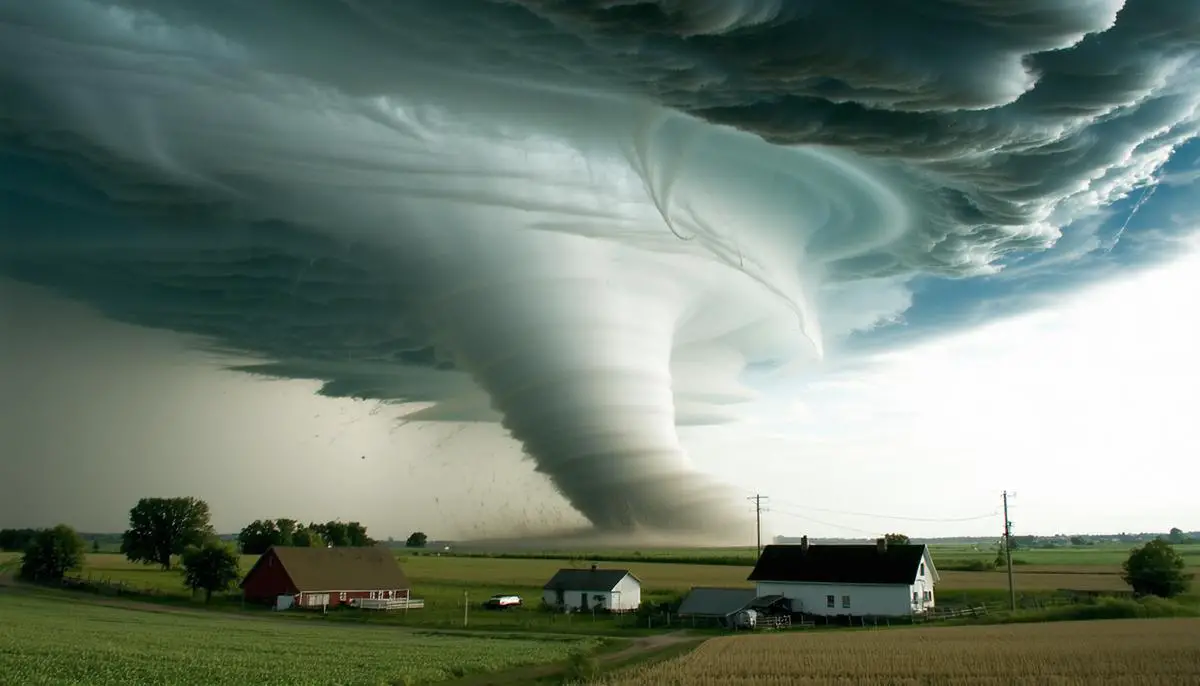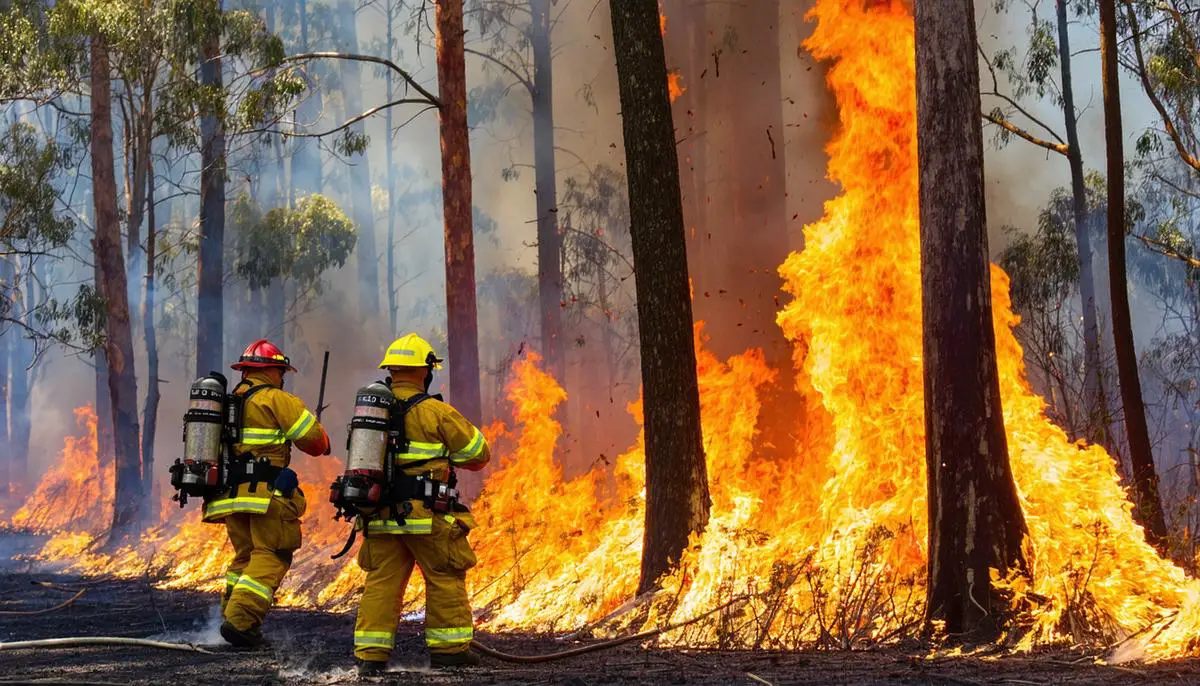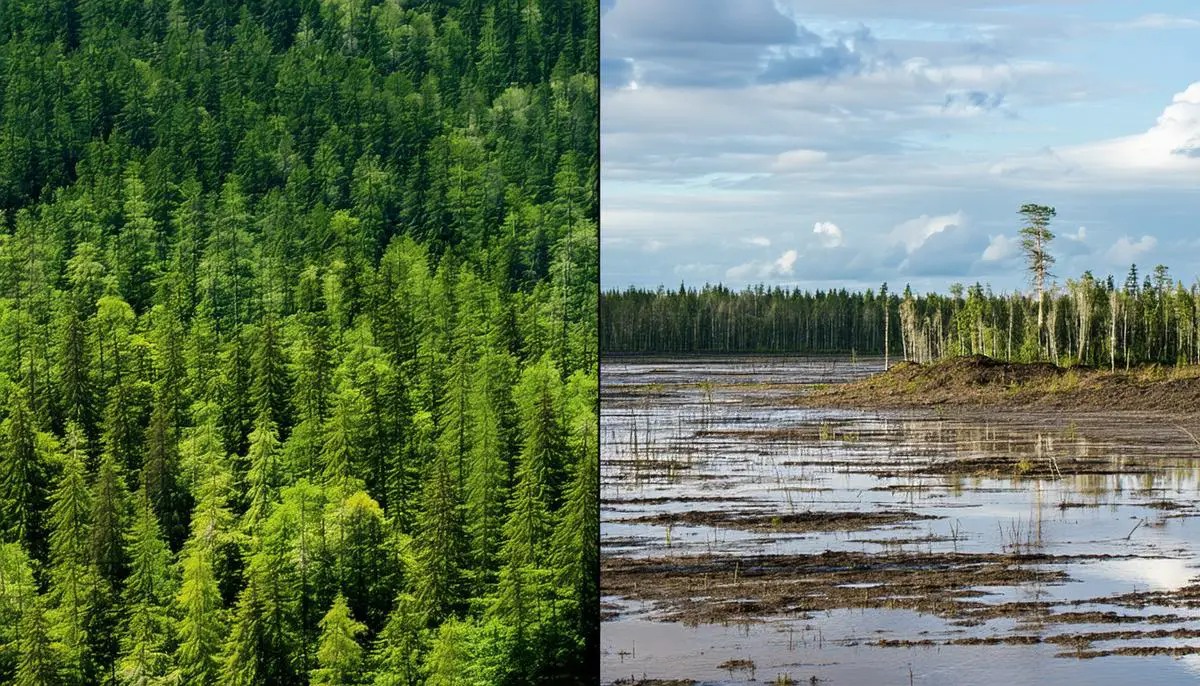Common Natural Disasters
Natural disasters manifest in various forms, each with its unique impact. They include:
- Storms
- Hurricanes
- Tornadoes
- Wildfires
- Floods
These events often develop under specific conditions, catching societies unprepared.
Hurricanes, massive storms formed over warm ocean waters, can devastate coastal regions. High-magnitude storms like Hurricane Katrina in 2005 leave trails of destruction, prompting mass evacuations and extensive recovery efforts.
Tornadoes, rotating air columns forming under thunderstorms, can strip land bare in minutes. Georgia alone has reported about 1,450 tornadoes over the last fifty years, with activity often peaking in spring.
Wildfires pose a significant threat, especially in dry climates with high winds. The 2007 fire in Georgia's southern forests destroyed homes and landscapes, requiring multi-state and international firefighting efforts.
Floods, often understated disasters, can unleash torrential water forces on unsuspecting areas. From Georgia's 2009 relentless rains to New Zealand's Northland region floods, these events cause drowning, contamination, and long-term disruption.
As climate change intensifies these events, the need for resilience and readiness grows. Understanding these phenomena and their frequencies aids in preparing for their potential impacts, building an approach defined by facts and figures rather than sensationalism.

Regional Impact and Examples
The geographic and climatic uniqueness of regions worldwide determines the natural disasters they face. Australia, New Zealand, and Georgia, USA, each confront distinct challenges shaped by their specific environments.
Australia is particularly vulnerable to heatwaves and bushfires. The "Black Summer" of 2019-2020 saw over 46 million acres scorched, resulting in loss of lives, homes, and significant impacts on wildlife. Australia also contends with tropical cyclones causing flooding, particularly in Queensland, where more than 80 natural disasters in the last decade have caused damages exceeding $16 billion.
New Zealand, positioned on the Pacific Ring of Fire, frequently experiences seismic activities. The Canterbury earthquakes in 2010 and 2011 caused economic losses reaching $22 billion. Flooding due to the nation's rugged topography and heavy rainfall often disrupts communities, as evidenced by a 2021 incident in Wellington where a single day's rain matched a month's worth of precipitation.
Georgia, USA, experiences varied weather events across its diverse landscapes:
- Atlanta's "Snowpocalypse" in 2014 paralyzed the urban center
- The remnants of Hurricane Katrina in 2005 caused record gasoline price spikes
- An influx of over 100,000 evacuees from neighboring Gulf States followed Katrina
These regional impacts emphasize how disasters often strike with little warning but leave lasting environmental and social scars. Understanding these dynamics is crucial in devising responsive, specific strategies that mitigate damage and enhance resilience.

Causes and Consequences
Natural disasters often result from a combination of natural and human influences. Climate change acts as a catalyst, intensifying extreme weather events and heightening the likelihood of droughts and wildfires. In Australia, the link between climate change and escalating bushfires is evident, while in Georgia, warmer atmospheric conditions contribute to more intense storms and frequent flooding.
Deforestation and erosion amplify these vulnerabilities. Clearing forests reduces the land's ability to absorb rainfall, leading to more severe flooding and increased landslide risk. In Southeast Asia, widespread deforestation has left landscapes vulnerable to flood events, disrupting local economies dependent on agriculture and tourism.
Tectonic activity, particularly in seismically active regions like New Zealand, results in earthquakes and tsunamis that pose immediate threats to human life and cause long-term infrastructure and economic devastation.
The consequences of these disasters extend beyond immediate physical destruction, affecting:
- Public health
- Economic stability
- Environmental integrity
Flooding often leads to waterborne diseases, while overcrowded shelters increase the risk of disease outbreaks. Economically, natural disasters impose heavy costs on nations and local governments, diverting funds from development projects to emergency response and reconstruction efforts.
Environmentally, the degradation caused by natural disasters sets back conservation efforts and threatens ecological balance, leading to long-term changes that affect both humans and wildlife.
Understanding these interactions is crucial for creating effective strategies that mitigate disaster impacts and enhance resilience. This involves not only managing emergencies when they occur but also adapting proactively to a changing climate, prioritizing ecological restoration, and planning resilient communities capable of withstanding nature's forces.

Disaster Preparedness and Management
Effective disaster preparedness and management are crucial in protecting communities from increasingly frequent and intense natural disasters. Building resilience involves a multilayered approach combining structural, societal, and individual preparedness measures. Successful disaster management integrates four distinct phases:
- Mitigation: Taking steps to reduce a disaster's potential impact, such as constructing sturdy infrastructure and enforcing stricter building codes. Innovative solutions like TrapBag barriers provide advanced defense against water intrusion and land degradation.
- Preparation: Focusing on readiness, including developing comprehensive emergency plans and ensuring each household has a 'go-bag' with essentials. Practicing evacuation drills and establishing communication plans ensures swift action when faced with danger.
- Response: Requiring well-coordinated efforts to provide immediate relief and support. Public health systems play a critical role in addressing urgent medical needs and preventing disease outbreaks. Early-warning systems enhance the ability to deliver timely and effective aid.
- Recovery: Involving rebuilding and revitalization, focusing on restoring normalcy and reducing future risks. This phase offers an opportunity to incorporate resilience principles into reconstruction efforts, emphasizing sustainable development that considers future climate scenarios.
Community awareness and education are vital to fostering a culture of resilience. Public engagement in disaster preparedness programs empowers individuals with the knowledge to handle emergencies effectively. Advocacy and activism, backed by sound policies and climate-informed decision-making, push for systemic changes that address the root causes of environmental vulnerabilities.
In an era marked by climate change and intensifying natural phenomena, proactive, informed, and community-focused disaster management strategies are essential. Combining technological advancements, innovative tools, public education, and strategic planning offers a way to mitigate disaster impacts and build communities better equipped to thrive amid adversities.
In the face of nature's power, understanding and preparation are our strongest allies. The impact of natural disasters is profound, affecting lives and reshaping landscapes. As we adapt to these challenges, fostering resilience within communities remains crucial. By embracing informed strategies and collective action, we can better handle the unpredictable forces that shape our world. How can you contribute to building a more resilient community in the face of natural disasters?
- United Nations Office for Disaster Risk Reduction. Terminology. UNDRR website.
- Centre for Research on the Epidemiology of Disasters. EM-DAT: The International Disaster Database. CRED website.
- Kouadio IK, Aljunid S, Kamigaki T, Hammad K, Oshitani H. Infectious diseases following natural disasters: prevention and control measures. Expert Rev Anti Infect Ther. 2012;10(1):95-104.
- Watson JT, Gayer M, Connolly MA. Epidemics after natural disasters. Emerg Infect Dis. 2007;13(1):1-5.
- Ready.gov. Build A Kit. Department of Homeland Security website.
![]()
